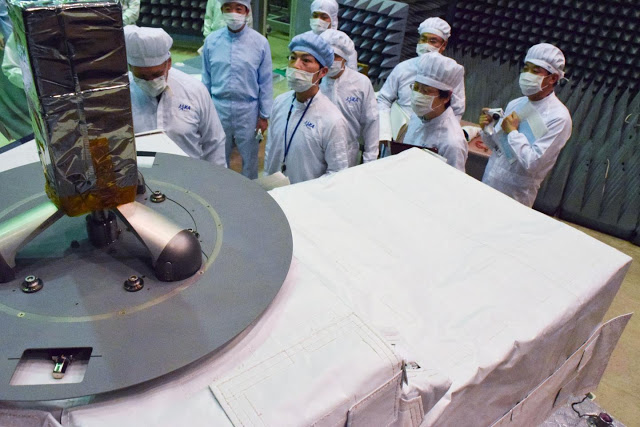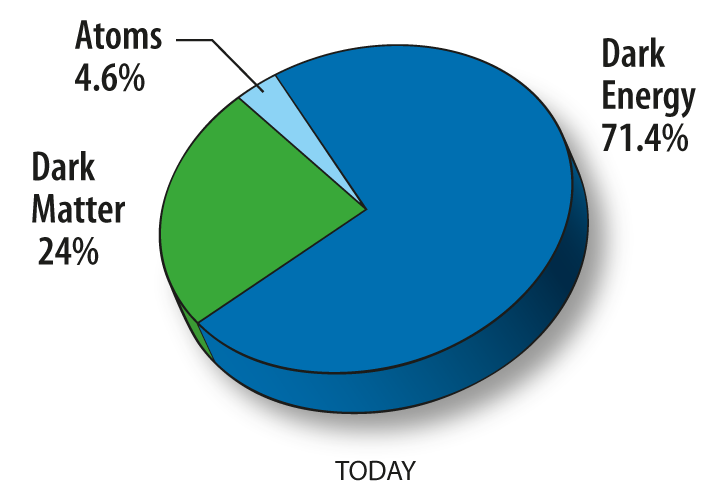| Online: | |
| Visits: | |
| Stories: |

| Story Views | |
| Now: | |
| Last Hour: | |
| Last 24 Hours: | |
| Total: | |
New Telescope Seeks Dark Matter and Particle Acceleration In Near Space
Peering into darkness can strike fear into the hearts of some, but a new space telescope will soon peer into the darkness of “near space” (within a few thousand light years of Earth). Scientists are using the telescope to seek answers related to the field of high-energy astrophysics.
The CALorimetric Electron Telescope (CALET) investigation will rely on the instrument to track the trajectory of cosmic ray particles and measure their charge and energy. The instrument is optimized for measuring electrons and gamma rays, which may contain the signature of dark matter or nearby sources of high-energy particle acceleration.
The Japan Aerospace Exploration Agency (JAXA) Kounotori H-II Transfer Vehicle (HTV-5) is seen berthed to the International Space Station. The external CALET experiment, which will search for signatures of dark matter, is seen being extracted from the unpressurized section by the station’s robotic arm, Canadarm2. An aurora over the Earth limb is visible in the background.
“We know that dark matter makes up about a quarter of the mass-energy of the universe, but we can’t see it optically and don’t know what it is,” said Dr. John Wefel, and CALET co-principal investigator for the US team. “If CALET can see an unambiguous signature of dark matter, it could potentially produce a new understanding of the nature of dark matter.”
Right now, scientists are much more certain what dark matter is not, rather than what it is. This research may help scientists identify dark matter and fit it, more accurately, into standard models of the universe.
CALET launched aboard the Japan Aerospace Exploration Agency (JAXA) H-II Transfer Vehicle “Kounotori” (HTV-5) in August 2015 and was placed on the International Space Station’s Japanese Experiment Module – Exposed Facility just days after its arrival.
The HTV5 CALorimetric Electron Telescope (CALET) Flight Crew Interface Test (FCIT). CALET will search for signatures of dark matter and provide the highest energy direct measurements of the cosmic ray electron spectrum.

Credit: NASA
From the resulting measurements, scientists must then separate electrons from the protons, gamma rays and the higher Z elements (chemical elements with >1 proton in the nucleus). They then sort the particles by energy to extend the existing data to higher energies and search for signatures of new astrophysics processes and phenomena like dark matter and nearby particle acceleration to study cosmic ray propagation in the galaxy.
“The major theoretical model attributes dark matter to weakly interacting massive particles (WIMPs), whose nature is predicted by various high energy physics models,” said Torii. “In these models, a WIMP would be its own antiparticle and, when two of them get together, they annihilate, producing known particles like electron/positron pairs, proton/anti-proton pairs, and gamma rays.”
Searching for excess annihilation products (i.e. electrons and gamma rays) is one way to try to identify a dark matter candidate and this is where CALET helps scientists. CALET joins another ISS investigation searching for excess annihilation products, the Alpha Magenetic Spectrometer or AMS, which is looking at positrons and antiprotons to identify dark matter.
“Dark matter is still a puzzle,” said Torii. “By measuring with good energy resolution the spectrum of high energy cosmic electrons and photons, CALET may make a discovery or exclude existing models.”
Credit: NASA
“The latter would be [a] huge achievement since no individual sources have ever been positively identified,” said Torii. “Such objects seem to be able to accelerate particles to energies far higher than we can achieve on Earth using the largest machines and we want to learn how nature does this, with possible applications here on Earth.”
Understanding the location of these sources as well as particle propagation (the time particles spend, and distance traveled, wandering around the galaxy) means scientists can infer the shape of the cosmic ray spectrum at the source. Gaining a better understanding of how cosmic rays originate and the mechanisms of particle acceleration and propagation is important to space travel and for understanding the radiation environment in space and on Earth.
“Basically, CALET is after new information about how our little corner of the universe works,” said Torii, who added that the investigation underscores the importance of the space station as a platform for performing investigations and for successful international collaboration.
Rachel Hobson
Source:




